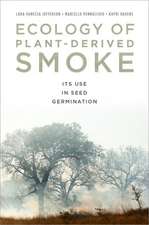Life History Evolution in Plants
Editat de Timo Olavi Vuorisalo, P. Mutikainenen Limba Engleză Paperback – 30 noi 2001
Preț: 947.98 lei
Preț vechi: 1156.07 lei
-18% Nou
Puncte Express: 1422
Preț estimativ în valută:
181.42€ • 196.99$ • 152.39£
181.42€ • 196.99$ • 152.39£
Carte tipărită la comandă
Livrare economică 23 aprilie-07 mai
Preluare comenzi: 021 569.72.76
Specificații
ISBN-13: 9781402002793
ISBN-10: 1402002793
Pagini: 364
Ilustrații: XIV, 348 p.
Dimensiuni: 155 x 235 x 19 mm
Greutate: 0.52 kg
Ediția:Softcover reprint of the original 1st ed. 1999
Editura: SPRINGER NETHERLANDS
Colecția Springer
Locul publicării:Dordrecht, Netherlands
ISBN-10: 1402002793
Pagini: 364
Ilustrații: XIV, 348 p.
Dimensiuni: 155 x 235 x 19 mm
Greutate: 0.52 kg
Ediția:Softcover reprint of the original 1st ed. 1999
Editura: SPRINGER NETHERLANDS
Colecția Springer
Locul publicării:Dordrecht, Netherlands
Public țintă
ResearchCuprins
1. Modularity and Plant Life Histories.- 1.1. Modularity: the concept.- 1.2. Life-history concepts and the modular hierarchy.- 1.3. Modularity, the allocation principle, and trade-offs.- 1.4. Modularity and sex.- 1.5. Conclusion.- 1.6. References.- 2. Modelling and Measuring Plant Life Histories.- 2.1. Introduction.- 2.2. Transition matrix models.- 2.3. Importance of demographic parameters in plants.- 2.4. Actual variation in transition rates.- 2.5. Trade-offs.- 2.6. Plant life histories and the environment.- 2.7. Concluding remarks.- 2.8. References.- 3. Fitness Interactions Among Plants: Optimal Defence and Evolutionary Game Theory.- 3.1. Introduction.- 3.2. Interactions between plants.- 3.3. Plant defence theory.- 3.4. Herbivory and interactions between plants.- 3.5. Concluding remarks.- 3.6. References.- 4. Genetic Variation In Life-History Traits: Heritability Estimates within and Genetic Differentiation Among Populations.- 4.1. The scope of this review.- 4.2. Evidence for genetic variation in life-history traits within populations: field and greenhouse experiments.- 4.3. Evidence for genetic differentiation among populations in life-history traits.- 4.4. Suggestions for future research.- 4.5. References.- Appendix 4.1.- Appendix 4.2.- 5. Resource Allocation, Trade-Offs, and Reproductive Effort in Plants.- 5.1. Introduction.- 5.2. The measurement of reproductive effort.- 5.3. Reproductive effort versus reproductive cost.- 5.4. Phenotypic versus genetic variation in reproductive effort.- 5.5. Developmental constraints.- 5.6. Conclusions.- 5.7. References.- 6. Phenological and Developmental Costs of Male Sex Function in Hermaphroditic Plants.- 6.1. Introduction.- 6.2. Why male function may be surprisingly costly in hermaphrodites.- 6.3. Next steps.- 6.4. References.-7. Evolution of Plant Dispersal.- 7.1. Introduction.- 7.2. A brief history of dispersal studies.- 7.3. Selection for dispersal.- 7.4. Patterns of dispersal features.- 7.5. Phylogenetic considerations.- 7.6. Concluding remarks.- 7.7. References.- 8. Senescence in Plants.- 8.1. Introduction.- 8.2. Identifying senescence.- 8.3. Senescence in plants.- 8.4. Necessary conditions for the evolution of senescence.- 8.5. Life-cycle models.- 8.6. Conclusions.- 8.7. References.- 9. Pathogens and Plant Life Histories.- 9.1. Introduction.- 9.2. Interactions between pathogens and plant life histories.- 9.3. Empirical evidence.- 9.4. Conclusions.- 9.5. References.- 10. Impact of Herbivore Tolerance and Resistance on Plant Life Histories.- 10.1. Introduction.- 10.2. Mechanisms of tolerance.- 10.3. Models of tolerance and resistance.- 10.4. Evidence for costs of tolerance and resistance.- 10.5. Discussion.- 10.6. References.
Recenzii
'[...] I found this book to be a useful refresher course on aspects of plant life history evolution that I had not considered for a while, and an excellent introduction to some topics about which I knew little. I recommend this book to postgraduate students (in the more affordable paperback edition) and to established researchers. It's a useful resource to allocate to your personal or institutional library.'
Plant Systematics and Evolution, 232 (2002)
Plant Systematics and Evolution, 232 (2002)












